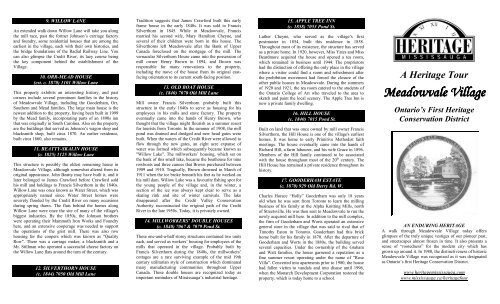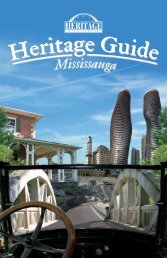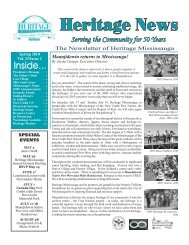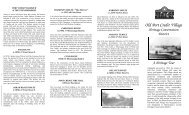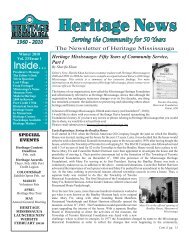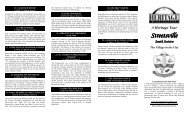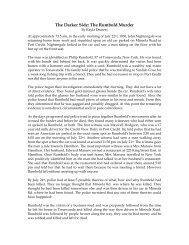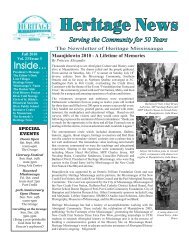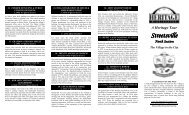Download the Meadowvale Village Heritage Tour Brochure
Download the Meadowvale Village Heritage Tour Brochure
Download the Meadowvale Village Heritage Tour Brochure
Create successful ePaper yourself
Turn your PDF publications into a flip-book with our unique Google optimized e-Paper software.
9. WILLOW LANE<br />
An extended walk down Willow Lane will take you along<br />
<strong>the</strong> mill race, past <strong>the</strong> former Johnson’s carriage factory<br />
and foundry, some residential houses that are among <strong>the</strong><br />
earliest in <strong>the</strong> village, each with <strong>the</strong>ir own histories, and<br />
<strong>the</strong> bridge foundations of <strong>the</strong> Radial Railway Line. You<br />
can also glimpse <strong>the</strong> Credit River, its lazy course being<br />
<strong>the</strong> key component behind <strong>the</strong> establishment of <strong>the</strong><br />
<strong>Village</strong>.<br />
10. ORR-MEAD HOUSE<br />
(est. c. 1870) 1101 Willow Lane<br />
This property exhibits an interesting history, and past<br />
owners include several prominent families in <strong>the</strong> history<br />
of <strong>Meadowvale</strong> <strong>Village</strong>, including <strong>the</strong> Gooderham, Orr,<br />
Sou<strong>the</strong>rn and Mead families. The large main house is <strong>the</strong><br />
newest addition to <strong>the</strong> property, having been built in 1999<br />
by <strong>the</strong> Mead family, incorporating parts of an 1890s inn<br />
that was originally in South Carolina. Also on <strong>the</strong> property<br />
are <strong>the</strong> buildings that served as Johnson’s wagon shop and<br />
blacksmith shop, built circa 1870. An earlier residence,<br />
built circa 1860, also remains.<br />
11. BEATTY-SKALIN HOUSE<br />
(c. 1825) 1125 Willow Lane<br />
This structure is possibly <strong>the</strong> oldest remaining house in<br />
<strong>Meadowvale</strong> <strong>Village</strong>, although somewhat altered from its<br />
original appearance. John Beatty may have built it, and it<br />
later belonged to James Crawford before Crawford sold<br />
his mill and holdings to Francis Silverthorn in <strong>the</strong> 1840s.<br />
Willow Lane was once known as Water Street, which was<br />
appropriately named since Water Street homes were<br />
severely flooded by <strong>the</strong> Credit River on many occasions<br />
during spring thaws. The flats behind <strong>the</strong> homes along<br />
Willow Lane were once <strong>the</strong> site of many of <strong>the</strong> village's<br />
biggest industries. By <strong>the</strong> 1850s, <strong>the</strong> Johnson bro<strong>the</strong>rs<br />
were operating <strong>the</strong>ir Mammoth Iron Works and Foundry<br />
here, and an extensive cooperage was needed to support<br />
<strong>the</strong> operations of <strong>the</strong> grist mill. There was also row<br />
housing for <strong>the</strong> coopers which was known as "Quality<br />
Row". There was a carriage maker, a blacksmith and a<br />
Mr. Stillman who operated a successful cheese factory on<br />
<strong>the</strong> Willow Lane flats around <strong>the</strong> turn of <strong>the</strong> century.<br />
12. SILVERTHORN HOUSE<br />
(c. 1844) 7050 Old Mill Lane<br />
Tradition suggests that James Crawford built this early<br />
frame house in <strong>the</strong> early 1840s. It was sold to Francis<br />
Silverthorn in 1845. While in <strong>Meadowvale</strong>, Francis<br />
married his second wife, Mary Hamilton Cheyne, and<br />
several of <strong>the</strong>ir children were born in this house. The<br />
Silverthorns left <strong>Meadowvale</strong> after <strong>the</strong> Bank of Upper<br />
Canada foreclosed on <strong>the</strong> mortgage of <strong>the</strong> mill. The<br />
vernacular Silverthorn House came into <strong>the</strong> possession of<br />
mill owner Henry Brown in 1894, and Brown was<br />
responsible for many renovations to <strong>the</strong> property,<br />
including <strong>the</strong> move of <strong>the</strong> house from its original eastfacing<br />
orientation to its current south-facing position.<br />
13. OLD BOAT HOUSE<br />
(c. 1840) 7070 Old Mill Lane<br />
Mill owner Francis Silverthorn probably built this<br />
structure in <strong>the</strong> early 1840s to serve as housing for his<br />
employees in his mills and stave factory. The property<br />
eventually came into <strong>the</strong> hands of Henry Brown, who<br />
thought that <strong>the</strong> village might flourish as a summer resort<br />
for tourists from Toronto. In <strong>the</strong> summer of 1908, <strong>the</strong> mill<br />
pond was drained and dredged and new head gates were<br />
built. When <strong>the</strong> waters of <strong>the</strong> Credit River were allowed to<br />
flow through <strong>the</strong> new gates, an eight acre expanse of<br />
water was formed which subsequently became known as<br />
"Willow Lake". The millworkers’ housing, which sat on<br />
<strong>the</strong> bank of this small lake, became <strong>the</strong> boathouse for nine<br />
rowboats and three canoes that Brown purchased between<br />
1909 and 1910. Tragically, Brown drowned in March of<br />
1911 when <strong>the</strong> ice broke beneath his feet as he worked on<br />
his mill dam. Willow Lake was a favourite fishing spot for<br />
<strong>the</strong> young people of <strong>the</strong> village and, in <strong>the</strong> winter, a<br />
section of <strong>the</strong> ice was always kept clear to serve as a<br />
skating rink and site of winter carnivals. The lake<br />
disappeared after <strong>the</strong> Credit Valley Conservation<br />
Authority reconstructed <strong>the</strong> original path of <strong>the</strong> Credit<br />
River in <strong>the</strong> late 1950s. Today, it is privately owned.<br />
14. MILLWORKERS’ DOUBLE HOUSES<br />
(c. 1840) 7067 & 7079 Pond St.<br />
These one-and-a-half storey structures contained two units<br />
each, and served as workers’ housing for employees of <strong>the</strong><br />
mills that operated in <strong>the</strong> village. Probably built by<br />
Francis Silverthorn during <strong>the</strong> 1840s, <strong>the</strong> millworkers’<br />
cottages are a rare surviving example of <strong>the</strong> mid 19th<br />
century utilitarian style of construction which dominated<br />
many manufacturing communities throughout Upper<br />
Canada. These double houses are recognized today as<br />
important reminders of Mississauga’s industrial heritage.<br />
15. APPLE TREE INN<br />
(c. 1858) 7053 Pond St.<br />
Lu<strong>the</strong>r Cheyne, who served as <strong>the</strong> village’s first<br />
postmaster in 1854, built this residence in 1858.<br />
Throughout most of its existence, <strong>the</strong> structure has served<br />
as a private home. In 1920, however, Miss Yates and Miss<br />
Beardmore acquired <strong>the</strong> house and opened a tea room,<br />
which remained in business until 1944. The proprietors<br />
had <strong>the</strong> distinction of offering <strong>the</strong> only place in <strong>the</strong> village<br />
where a visitor could find a room and refreshment after<br />
<strong>the</strong> prohibition movement had forced <strong>the</strong> closure of <strong>the</strong><br />
o<strong>the</strong>r public houses in <strong>Meadowvale</strong>. During <strong>the</strong> summers<br />
of 1920 and 1921, <strong>the</strong> tea room catered to <strong>the</strong> students of<br />
<strong>the</strong> Ontario College of Art who traveled to <strong>the</strong> area to<br />
sketch and paint <strong>the</strong> local scenery. The Apple Tree Inn is<br />
now a private family dwelling.<br />
16. HILL HOUSE<br />
(c. 1840) 7015 Pond St.<br />
Built on land that was once owned by mill owner Francis<br />
Silverthorn, <strong>the</strong> Hill House is one of <strong>the</strong> village's earliest<br />
homes. It was home to early Primitive Methodist faith<br />
meetings. The house eventually came into <strong>the</strong> hands of<br />
Richard Hill, a farm labourer, and his wife Grace in 1896.<br />
Members of <strong>the</strong> Hill family continued to be associated<br />
with <strong>the</strong> house throughout most of <strong>the</strong> 20 th century. The<br />
Hill House has remained a private residence throughout its<br />
history.<br />
17. GOODERHAM ESTATE<br />
(c. 1870) 929 Old Derry Rd. W.<br />
Charles Horace “Holly” Gooderham was only 18 years<br />
old when he was sent from Toronto to learn <strong>the</strong> milling<br />
business of his family at <strong>the</strong> Alpha Knitting Mills, north<br />
of Streetsville. He was <strong>the</strong>n sent to <strong>Meadowvale</strong> to run <strong>the</strong><br />
newly acquired mill here. In addition to <strong>the</strong> mill complex,<br />
<strong>the</strong> firm of Gooderham and Worts operated an extensive<br />
general store in <strong>the</strong> village that was said to rival that of<br />
Timothy Eaton in Toronto. Gooderham had this brick<br />
home built for his family in 1870. After <strong>the</strong> departure of<br />
Gooderham and Worts in <strong>the</strong> 1880s, <strong>the</strong> building served<br />
several capacities. Under <strong>the</strong> ownership of <strong>the</strong> Graham<br />
and Watt families, <strong>the</strong> house garnered a reputation as a<br />
fine summer resort operating under <strong>the</strong> name of “Rose<br />
Villa”. Converted into apartments prior to 1980, <strong>the</strong> house<br />
had fallen victim to vandals and into disuse until 1996,<br />
when <strong>the</strong> Monarch Development Corporation restored <strong>the</strong><br />
property, which is today home to a school.<br />
A <strong>Heritage</strong> <strong>Tour</strong><br />
<strong>Meadowvale</strong> <strong>Village</strong><br />
Ontario’s First <strong>Heritage</strong><br />
Conservation District<br />
AN ENDURING HERITAGE<br />
A walk through <strong>Meadowvale</strong> <strong>Village</strong> today offers<br />
glimpses of <strong>the</strong> truly unique vestiges of our pioneer past,<br />
and streetscapes almost frozen in time. It also presents a<br />
sense of “rootedness” for <strong>the</strong> modern city which has<br />
grown up around it. In 1980, <strong>the</strong> distinctiveness of historic<br />
<strong>Meadowvale</strong> <strong>Village</strong> was recognized as it was designated<br />
as Ontario’s first <strong>Heritage</strong> Conservation District.<br />
www.heritagemississauga.com<br />
www.mississauga.ca/heritagefour
HISTORIC MEADOWVALE VILLAGE<br />
MEADOWVALE HISTORY<br />
The story of <strong>Meadowvale</strong> <strong>Village</strong> begins in 1819 when<br />
twenty-nine families emigrated from New York State and<br />
settled in this area. These settlers, led by “Squire” John<br />
Beatty, were seeking a new home under <strong>the</strong> British Flag,<br />
having grown tired of anti-British sentiment in <strong>the</strong> United<br />
States following <strong>the</strong> War of 1812. On May 1 st , 1819,<br />
Beatty led a caravan of 29 wagons from New York. The<br />
party travelled along <strong>the</strong> Niagara Peninsula, following <strong>the</strong><br />
Lake Ontario shoreline, eventually reaching what would<br />
become Port Credit. Here, <strong>the</strong> group split into two, with<br />
several families following Thomas Graham, settling in <strong>the</strong><br />
eastern part of <strong>the</strong> New Survey of Toronto Township<br />
(modern Mississauga). The o<strong>the</strong>r group, led by Beatty,<br />
settled here. The newcomers found <strong>the</strong>ir chosen land<br />
densely covered by extensive pine forests. Each family<br />
was given 200 acres. However, <strong>the</strong> Crown would not issue<br />
grants until settlement duties had been completed. The<br />
duties included <strong>the</strong> construction of a dwelling and <strong>the</strong><br />
clearing and fencing of a percentage of <strong>the</strong> settlers’ land.<br />
Because of <strong>the</strong> quiet pastoral beauty which greeted <strong>the</strong>se<br />
early pioneers, <strong>the</strong> area was appropriately dubbed<br />
“<strong>Meadowvale</strong>”. When Beatty left <strong>the</strong> area in 1831 to<br />
pursue a career in <strong>the</strong> Methodist ministry, John Crawford<br />
purchased Beatty’s holdings and quickly established <strong>the</strong><br />
village’s first sawmill. John Simpson who, in 1836,<br />
established a sawmill and a carding mill, to which farmers<br />
brought <strong>the</strong>ir wool to be spun into yarn, closely followed<br />
Crawford’s endeavours. Simpson quickly became an<br />
affluent member of <strong>the</strong> community and is considered by<br />
many as <strong>the</strong> founding fa<strong>the</strong>r of <strong>the</strong> village. In 1836,<br />
<strong>Meadowvale</strong> had reached a sufficient size to be<br />
considered a village. Milling continued as <strong>the</strong> lifeblood of<br />
<strong>the</strong> community for many years, and <strong>the</strong> burgeoning<br />
village’s prosperity was directly linked to <strong>the</strong> success of<br />
<strong>the</strong> mills. Francis Silverthorn moved to <strong>Meadowvale</strong> in<br />
1844, and, with his expansions to Crawford’s mill<br />
complex, <strong>the</strong> community also acquired a grist mill. By <strong>the</strong><br />
1850s, <strong>the</strong>re were two hotels, a wagon shop, foundry and<br />
a school to support <strong>the</strong> growing population. Due to <strong>the</strong><br />
well-preserved historic character of <strong>the</strong> area, <strong>Meadowvale</strong><br />
<strong>Village</strong> earned <strong>the</strong> distinction of becoming Ontario's first<br />
<strong>Heritage</strong> Conservation District in 1980.<br />
1. MEADOWVALE COMMUNITY HALL<br />
(c. 1871) 6970 Second Line W.<br />
Built on land donated by <strong>the</strong> Simpson family in 1871, <strong>the</strong><br />
present Community Hall served as <strong>Meadowvale</strong> <strong>Village</strong>’s<br />
second school house. The first had been built in 1851 at<br />
<strong>the</strong> corner of Barberry Lane and Second Line. After <strong>the</strong><br />
construction of this building, <strong>the</strong> first school was<br />
converted into a private residence, and was lost during a<br />
fire in 1974. Unlike larger communities in <strong>the</strong> region,<br />
<strong>Meadowvale</strong> did not have a grammar school, so students<br />
wishing to receive higher education had to travel to ei<strong>the</strong>r<br />
Streetsville or Brampton. In 1959, a larger, more modern<br />
public school was built to service <strong>the</strong> community. Since<br />
1968, this building has been used as a community hall.<br />
Extensive repairs were undertaken in 1980-81 to reinforce<br />
<strong>the</strong> roof and foundations and to provide an adequate water<br />
system. Additional restoration work was done in 1993.<br />
2. MEADOWVALE UNITED CHURCH<br />
(c. 1863) 1010 Old Derry Rd. W.<br />
In religious matters, Methodism held sway in<br />
<strong>Meadowvale</strong> and was <strong>the</strong> only denomination to establish a<br />
permanent church in <strong>the</strong> village. Those of Presbyterian<br />
faith travelled to Streetsville, <strong>the</strong> Anglicans to Derry West<br />
or Churchville, while Catholics would attend mass at<br />
Elmbank. Methodists began holding camp meetings in <strong>the</strong><br />
<strong>Meadowvale</strong> in 1821. A new, permanent home for <strong>the</strong><br />
Wesleyan Methodists was established in 1863. Reverend<br />
Charles Fish held <strong>the</strong> first revival services. Church<br />
meetings became <strong>the</strong> focal point of social life in<br />
<strong>Meadowvale</strong>, including social teas, church concerts,<br />
Sunday school picnics, Harvest Home services and camp<br />
meetings. In <strong>the</strong> early years of <strong>the</strong> church, Sunday school<br />
was taught by Mrs. Baskerville, while Mr. Charles<br />
Switzer and Miss Jennie Gooderham ran <strong>the</strong> choir. Miss<br />
Jessie Gooderham was <strong>the</strong> church organist.<br />
3. GRAHAM-PEARSON HOUSE<br />
(c. 1870) 1020 Old Derry Rd. W.<br />
This attractive, late Victorian residence features <strong>the</strong> red<br />
brick and buff trim combination that is popular throughout<br />
Peel County. The house was built by James Graham for<br />
son Thomas Graham and his wife, Elizabeth Simpson.<br />
Elizabeth’s fa<strong>the</strong>r, John Simpson, had donated <strong>the</strong> land on<br />
which <strong>the</strong> house was built. After <strong>the</strong> Grahams moved into<br />
<strong>the</strong> Gooderham Mansion, Charles Switzer, store owner<br />
and village postmaster during <strong>the</strong> 1880s, purchased this<br />
residence from <strong>the</strong> family. The Pearson name became<br />
associated with <strong>the</strong> property after Samuel Pearson sold his<br />
200-acre farm south of <strong>Meadowvale</strong> and retired to <strong>the</strong><br />
village after <strong>the</strong> turn of <strong>the</strong> century. The house remains in<br />
use as a well-preserved private residence.<br />
4. LAMBE-HOLMES HOUSE<br />
(c. 1893) 1045 Old Derry Rd. W.<br />
This house was built around 1893 by Albert Lambe.<br />
Albert was born in 1854 and was raised in <strong>Meadowvale</strong><br />
by John Simpson. In 1884, <strong>the</strong> industrious Albert bought a<br />
sawmill and converted <strong>the</strong> Bell Hotel into a rooming<br />
house for his employees. In 1893, Albert bought this<br />
property from <strong>the</strong> James Ward estate, whose store had<br />
burned earlier in <strong>the</strong> year, and built <strong>the</strong> house. Albert,<br />
toge<strong>the</strong>r with his son William, also operated a store,<br />
bakery, and post office in <strong>the</strong> village. Albert retired in<br />
1913, and passed away in 1925. The house was later<br />
purchased by <strong>the</strong> Holmes family and remains a private<br />
family home today.<br />
5. COMMERCIAL HOTEL<br />
(c. 1852) 1051 Old Derry Rd. W.<br />
This brick hotel was built by Mat<strong>the</strong>w Laidlaw in 1852<br />
and, for a short time, Laidlaw operated a public house that<br />
became known as <strong>the</strong> “Commercial Hotel”. Laidlaw left<br />
<strong>the</strong> hotel business to run <strong>the</strong> general store that James Ward<br />
had built in 1848. After Laidlaw's departure, <strong>the</strong> hotel<br />
passed through <strong>the</strong> ownership of several people, including<br />
Moses Strong, Joseph Kearney and Christopher Rutledge.<br />
John Callaghan was <strong>the</strong> last person to operate a hotel in<br />
<strong>the</strong> building around <strong>the</strong> turn of <strong>the</strong> century. Prohibition<br />
swept through <strong>the</strong> county shortly afterwards, and public<br />
houses, which relied on <strong>the</strong> liquor trade to stay in<br />
business, were soon forced to close. William Lambe,<br />
general store owner and postmaster, converted <strong>the</strong><br />
renamed “Brick Hotel” into a private residence. Around<br />
1950 <strong>the</strong> original two-storey veranda was removed.<br />
Robert Robson rebuilt it in 2006.<br />
6. STREETSCAPES<br />
Strolling through <strong>Meadowvale</strong> <strong>Village</strong> offers a remarkable<br />
chance to glimpse streetscapes frozen in time and a<br />
landscape of <strong>the</strong> past. Much of <strong>the</strong> village remains little<br />
altered from <strong>the</strong> mid 19 th century.<br />
7. BELL HOTEL<br />
(c. 1844) 1090 Old Derry Rd. W.<br />
George Bell, after whom this building is named, was a<br />
blacksmith by trade. He purchased land from mill owner<br />
John Simpson in <strong>the</strong> 1840s and built <strong>the</strong> first hotel in <strong>the</strong><br />
village in 1844. The frame structure operated under <strong>the</strong><br />
name of <strong>the</strong> “Temperance Hotel”. The location, beside <strong>the</strong><br />
bustling activity of Silverthorn's <strong>Meadowvale</strong> Mills, was<br />
ideal for an inn that could accommodate farmers and<br />
teamsters who were shipping grain to and from <strong>the</strong> mill.<br />
Albert Lambe, <strong>the</strong> adopted son of John Simpson, was<br />
responsible for converting <strong>the</strong> Bell Hotel into a private<br />
residence. Lambe died in 1925, at 71 years of age. The<br />
Bell Hotel is now a private residence.<br />
8. MEADOWVALE MILL RUINS<br />
(Est. 1845) Old Mill Lane<br />
The lazy course of <strong>the</strong> Credit River belies its importance<br />
to <strong>the</strong> establishment of <strong>Meadowvale</strong> <strong>Village</strong>. The<br />
founding of mills along <strong>the</strong> course of <strong>the</strong> river provided<br />
<strong>the</strong> single greatest incentive to <strong>the</strong> growth of <strong>the</strong><br />
surrounding community. The early mills operated by<br />
Simpson and Crawford paved <strong>the</strong> way for new growth.<br />
Francis Silverthorn, son of one <strong>the</strong> Township’s first<br />
pioneers, arrived in <strong>Meadowvale</strong>, purchased a portion of<br />
John Crawford’s mill allowance, and entered into<br />
competition with John Simpson. He built a dam and<br />
millrace and erected a large sawmill. Silverthorn<br />
expanded his complex in 1845, constructing a large grist<br />
mill. In 1853 tragically <strong>the</strong> mill and its 10,000 bushels of<br />
wheat burned. With new financial backing from <strong>the</strong> Bank<br />
of Upper Canada, Silverthorn quickly rebuilt. Unluckily<br />
<strong>the</strong> wheat market collapsed in 1860 following <strong>the</strong> Crimean<br />
War, and <strong>the</strong> firm of Gooderham and Worts took over<br />
operation of <strong>the</strong> mill. After <strong>the</strong> departure of Gooderham<br />
and Worts in 1880, <strong>the</strong> grist mill fell into disuse by <strong>the</strong><br />
1950s and was demolished in 1954.


